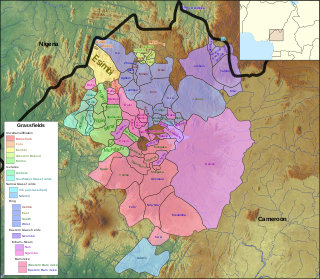Related Research Articles

Southern Bantoid is a branch of the Bantoid language family. It consists of the Bantu languages along with several small branches and isolates of eastern Nigeria and west-central Cameroon. Since the Bantu languages are spoken across most of Sub-Saharan Africa, Southern Bantoid comprises 643 languages as counted by Ethnologue, though many of these are mutually intelligible.

Bantoid is a major branch of the Benue–Congo language family. It consists of the Northern Bantoid languages and the Southern Bantoid languages, a division which also includes the Bantu languages that constitute the overwhelming majority and to which Bantoid is named after.

The Tikar are a Northern Bantoid ethnic group native to Cameroon

The Makaa–Njem languages are a group of Bantu languages spoken in Cameroon, the Central African Republic, Equatorial Guinea, Gabon and the Republic of the Congo. They are coded Zone A.80 in Guthrie's classification.
Myene is a cluster of closely related Bantu varieties spoken in Gabon by about 46,000 people. It is perhaps the most divergent of the Narrow Bantu languages, though Nurse & Philippson (2003) place it in with the Tsogo languages (B.30). The more distinctive varieties are Mpongwe (Pongoué), Galwa (Galloa), and Nkomi.

The Grassfields languages are a branch of Southern Bantoid spoken in the Western High Plateau of Cameroon and some parts of Taraba state, Nigeria. Better known Grassfields languages include the Eastern Grassfields languages Bamun, Yamba and the Ring language Kom. The languages are closely related, sharing approximately half of their vocabulary.
Makonde, or Kimakonde, is the language spoken by the Makonde, an ethnic group in southeast Tanzania and northern Mozambique. Makonde is a central Bantu language closely related to Yao. The Matembwe and Mabiha (Maviha) dialects are divergent, and may not be Makonde.
Tikar is a Northern Bantoid language spoken in Cameroon by the Bankim, Ngambe and related Tikar peoples as well as by the Bedzan Pygmies. Variants of the name are Tikali, Tikar-East, Tikari, Tingkala.
Yans (Yanzi) is a Bantu language spoken in the Democratic Republic of the Congo by the Bayanzi.
Tongwe (Sitongwe) and Bende (Sibende) constitute a clade of Bantu languages coded Zone F.10 in Guthrie's classification. According to Nurse & Philippson (2003), they form a valid node. Indeed, at 90% lexical similarity they may be dialects of a single language.
Kuba is a Bantu language of Kasai, Democratic Republic of Congo.
Holoholo is a Bantu language of DR Congo and formerly in Tanzania spoken by the Holoholo people on either side of Lake Tanganyika. Classification is uncertain, but it may belong with the Takama group.
Lwalu, also known as Lwalwa, is a Bantu language of the Democratic Republic of the Congo. Its classification is uncertain: Nurse (2003), following Ahmed (1995), assigns all of Guthrie's L.20 languages to Luban, including Lwalu.
Bango, is a Bantu language spoken in the Democratic Republic of Congo. Ethnologue suggests it may be a dialect of Budza, but Nurse & Philippson (2003) list it as one of the Bwa languages.
Njerep (Njerup) is a Mambiloid language spoken in the Adamawa Region of Cameroon. Njerep is essentially extinct, with only 4 people who speak it at home. Though word lists and grammatical information have been collected from these people, the information remains fragmented.
Twendi, or Cambap as it is also known, is a nearly extinct Mambiloid language of Cameroon. Speakers have largely shifted to the closely related language Kwanja, and Twendi has not been passed down to children for decades. The language is spoken in the villages of Cambap and Sanga on the Tikar Plain by no more than 30 people, the youngest of whom were born in the 1940s.
Luna is a Bantu language of eastern Democratic Republic of the Congo. Assigned by Guthrie to a group called Songe (L.20), it is presumably one of the Luban languages established by Ahmed (1995), like most of the other Songe languages, though it was not specifically addressed. Ruhlen (1987) agrees in placing it with the Luban languages.
Mashi (Kamaxi), or Kwandu, is a Bantu language of Zambia and Angola. It was assigned by Guthrie to Bantu group K.30, which Pfouts (2003) established as part of the Kavango–Southwest branch of Bantu. Though not specifically addressed, Mashi may be in that family as well.
Ndombe (Dombe) is a Bantu language of Angola. It was assigned by Guthrie to Bantu group R.10, which apart from Umbundu Pfouts (2003) established as part of the Kavango–Southwest branch of Bantu. Though not specifically addressed, Ndombe may be in that branch as well.
Suku is a Bantu language of the Democratic Republic of the Congo.